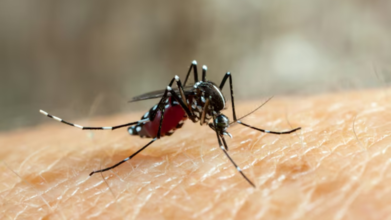- Health Conditions A-Z
- Health & Wellness
- Nutrition
- Fitness
- Health News
- Ayurveda
- Videos
- Medicine A-Z
- Parenting
What Is Chikungunya And How Can It Be Prevented?

Chikungunya Disease and Prevention (Credits-Freepik)
Overview
This is a disease that is transmitted from mosquitoes to humans and affects many people in the world. Found in densely populated countries and continents, like Africa, Asia and the tropics of the Americas, this has severe symptoms. This viral disease is caused by the Chikungunya virus of the Togaviridae. First identified in the United Republic of Tanzania in 1952 and subsequently in other countries like Africa and Asia. Since 2004 the outbreak of CHIKV virus has become more widespread and caused partly due to the viral adaptations allowing the virus to be spread more easily by Aedes albopictus mosquitoes. The transmission has been noted to persist in countries where there is a large population, but interestingly, the transmission has been interrupted on islands where a high proportion of the population is infected and then immune.
Symptoms
The onset of the disease is usually in 4-8 days and after a bite of an infected mosquitoes, it is characterized by an abrupt onset of fever and then joint pain. This joint pain is severed and lasts for a few days but may prolong for months maybe even years. Other signs are joint swelling, muscle pains, headache, nausea, fatigue and rash. These symptoms also overlap with those of dengue and Zika virus and can be misdiagnosed. Most people fully recover from the infection and experience only mild and sometimes the infection even goes unrecognized. However, there have been cases of eye, heart, and neurological complications. The elderly and newborns are more susceptible to the infection and if they have any underlying conditions then they are likely to become severely ill increasing the risk of death.
Diagnosis and treatment
The diagnosis and treatment of the virus may be done by blood sampling and other tests like reverse transcriptase–polymerase chain reaction (RT–PCR). Other tests detect the activity of the antibodies. These can be detected in the first week after illness onset and can be detected for about 2 months. Many clinical measures can be taken to address fever and joint pain. But there is no specific anti-viral drug treatment for the virus.
Preventing Chikungunya
As this disease is caused by the bite of a mosquito, you must reduce the opportunities to let the mosquito breed. Mosquitoes bite during the day and night, and for people who live in risk areas like southeast Asia, Africa and tropical regions of America, many outbreaks happen each year. The best way to prevent it is to protect yourself from the mosquito's bite. You also must get vaccinated before travelling to any of these regions. Use insect repellent, and wear long-sleeved shirts and pants. You can also treat your clothes and gear with permethrin. As we all know, they tend to breed in humid places and places where they have access to water, so try to close the rooms that are air-conditioned with screens and windows. Use nets and mosquito repellents if you are sleeping outside. There are many different types of mosquito repellents like paper, liquid etc, and they are quite effective. If your job needs, you to be stationary for long hours or frequently go outside you must take the necessary precautions.
Will The Old Flu Vaccine Protect You Against The New Subclade K?

Credits: iStock
While H3N2 flu cases are surging, one question that is being asked time and again is whether the old vaccines provide protection against this new variant. While the new strain of virus was detected after the vaccine had already undergone its update, the good news is that it still provides the best protection against the illness from H3N2 strains.
The real reason why concerns are prompted about the effectiveness of the seasonal vaccine is because the virus underwent more mutation than scientists expected over summers. This mutant is called the 'subclade K' or 'super flu'. While it is true that most cases this season are of the 'super flu' strain, experts say that the flu jab is still offering a strong protection.
How Effective Is The Flu Jab Against The New Flu Strain?
"The vaccine remains the most effective means to prevent disease. We still want to encourage people to get the vaccine," said Professor Antonia Ho, Professor and Honorary Consultant in Infectious Diseases at the University of Glasgow. Experts have stressed enough on the immunity that one can receive from the vaccine that that these flu jab remain the best defense against the flu, even though the current strain circulated may have drifted away from the strain included in this year's jab.
Data from the UK Health Security Agency (UKHSA) also show that vaccines is performing as expect, despite the emergence of subclade K.
How Is The Flu Jab Developed?
Every year, experts from the World Health Organization, the Centers for Disease Control and Prevention, and other global health agencies closely track flu trends around the world. They study which strains are spreading and use that data to predict which ones are most likely to dominate the upcoming flu season. The annual flu vaccine is then designed to protect against three or four of those strains.
It’s also worth understanding that more than one influenza A strain usually circulates at the same time. So even if the vaccine is not an exact match for a newer H3N2 strain, it still protects against other common flu viruses, which matters, notes Stony Brook Medicine.
When a new variant emerges, the flu shot can still offer what doctors call cross-protection. In simple terms, the antibodies your body makes after vaccination can recognize similar flu viruses and respond to them. You might still get sick, but the vaccine greatly lowers the chances of severe illness, hospitalization, or worse.
The vaccine offers protection against both types of influenza, including A and B.
Also Read: The New Flu Strain Emerged Too Late For Vaccines, And It Is Already Causing Outbreaks
Is There Any Difference Between Influenza A and B?
Influenza A
Influenza A changes quickly. Its genetic makeup shifts often, which is why new strains keep emerging and why it can trigger large outbreaks. It usually shows up early in the flu season and has been responsible for every major flu pandemic recorded so far.
Influenza B
Influenza B is more stable and does not change as rapidly from year to year. It tends to appear later in the season, often peaking in late winter or spring. While it does not cause pandemics, it can still lead to serious illness, particularly in children and young adults.
What Is The Normal Sperm Count To Get Pregnant? Expert Explains

Credits: Canva
When talking about fertility in routine practice, we usually refer to the World Health Organization’s guideline of roughly 15 million sperm per millilitre (and around 39–40 million total per ejaculate) as the lower boundary of “normal.”
But the count alone doesn’t tell the full story. The quality of sperm, their motility, shape, and the couple’s overall reproductive health are equally important. We got in touch with Dr. Meenakshi Priya, Clinical Director & Fertility Specialist, Nova IVF Fertility, Coimbatore, who told us more about the same.
What Is The Normal Sperm Count To Get Pregnant?
Dr Meenakshi said, “Think of sperm count like lottery tickets. More tickets (higher count) give you better odds, fewer tickets lower your chances — but even one well-functioning ticket (a motile, properly shaped sperm) can win.”
That’s why fertility clinics look at several factors: concentration, total number, progressive motility (whether sperm swim forward), and morphology (shape). The WHO manual provides the standard method and cut-offs used worldwide in labs, serving as the referee for semen analysis.
However, numbers matter clinically. Research over decades shows fertility starts to drop gradually below about 40 million/ml (or in older studies, 40 million total per ejaculate was a useful marker). The WHO threshold of 15 million/ml marks the lower edge of normal — values between 15 and 40 are a “grey zone,” where conception is possible but may take longer. So a man with 12 million/ml isn’t infertile, but the couple might need help like IUI or IVF depending on other factors.
But don’t get fixated on one number. A “normal” semen report is a combination of factors:
• Concentration ≥15 million/ml
• Total sperm count ≥39–40 million per ejaculate
• Progressive motility roughly >30%
• Normal morphology about 4% (Kruger criteria)
What Changes A Sperm Count?
Lifestyle and health have a big impact on sperm. Smoking, heavy drinking, extra weight, prolonged heat exposure (saunas, hot tubs, tight underwear), certain medications, recent fevers, and conditions like varicocele or hormonal imbalances can all lower the numbers.
The good news? Most of these are reversible. Dr Meenakshi said, “Quitting smoking, reducing alcohol, losing a bit of weight, avoiding hot tubs for a few months, and treating infections can improve sperm.” Remember, sperm take time to renew but it usually takes 2–3 months of healthier habits for improvements to appear in a report. Be patient; your body is making changes even if you don’t see results immediately.
When To Be Concerned And Consult A Doctor?
If semen analysis repeatedly shows very low sperm (oligozoospermia), no sperm (azoospermia), poor motility, or if a couple has been trying for a year (or six months if the woman is over 35) without success, it’s time to consult a specialist. One abnormal test isn’t the final word — tests are usually repeated, and a more thorough assessment may include hormone checks, ultrasounds, or genetic tests if needed.
Dr Meenakshi said, “Sperm count gives a headline, not the full story. It’s a useful screening tool, but fertility decisions are personal. If you’re concerned, get a proper semen analysis and speak with a fertility specialist — many fertility issues are treatable, and acting early makes a real difference.”
Norovirus 2025: How Contagious Is the Stomach Bug Spreading Across the US

Credits: Canva
Norovirus, often called the stomach bug, has returned. Between August 1 and December 11, health officials recorded 268 norovirus outbreaks, with numbers climbing steadily as winter travel increases and more people spend time indoors. The virus triggers stomach-related symptoms such as nausea, vomiting, diarrhea, and abdominal pain or cramping.
Some people also develop fever, headaches, and body aches. Although case numbers are not rising as sharply as flu, doctors remain concerned because norovirus spreads extremely easily. Making matters worse, norovirus is difficult to kill. Many of the common precautions used against flu and COVID offer little protection against this so-called winter vomiting bug.
How Contagious Is the Norovirus?
Norovirus is among the most infectious viruses doctors deal with. “It can tear through a household and then circle back, with people repeatedly passing it to each other,” says Amy Edwards, MD, associate professor of pediatrics at Case Western Reserve University School of Medicine in Cleveland, Ohio, who specializes in infectious diseases. “It also spreads very quickly in crowded, closed settings like cruise ships.”
While contaminated surfaces can transmit norovirus, doctors say person-to-person spread is most common. An infected person can pass on the virus even before symptoms appear, throughout the illness, and after they start to feel better, Jennings warns.
What to Do If You Get Norovirus?
For most people, norovirus symptoms ease within a few days, according to Jennings. However, the illness can be more serious for those with weaker immune systems, including young children, older adults, and people with certain health conditions.
If you think you have norovirus, focus on staying well hydrated. Ongoing vomiting can quickly lead to fluid loss and electrolyte imbalance. To prevent nausea from getting worse, Jennings recommends taking small sips of clear fluids like water, ginger ale, or coconut water.
Most importantly, seek medical care right away if you become dehydrated or if diarrhea lasts for weeks. Fischer explains that dehydration may cause sunken eyes, less frequent urination, dry skin and mouth, and extreme tiredness.
Common Norovirus Symptoms That You Should Be Aware Of
Norovirus symptoms often come on suddenly and may include:
- Nausea
- Vomiting
- Stomach pain or cramps
- Watery or loose diarrhea
- General feeling of illness
- Mild fever
- Muscle aches
Symptoms usually begin 12 to 48 hours after exposure and last for one to three days. Even after recovery, people can continue shedding the virus in their stool for weeks. In some cases, especially among those with other medical conditions, shedding can continue for months. Some people infected with norovirus never develop symptoms at all. Even so, they can still spread the virus to others.
Norovirus Causes
Norovirus spreads very easily from one person to another. Because it is highly contagious, an infection can pass quickly through homes, schools, or other shared spaces. The virus is released through stool and vomit, and a person can spread it from the moment symptoms begin until several days after they feel better. Norovirus can also survive on surfaces and objects for days or even weeks.
You can catch norovirus by:
- Eating food that has been contaminated
- Drinking unsafe or contaminated water
- Touching your mouth after your hands have come into contact with a contaminated surface or object
- Having close contact with someone who is infected with norovirus
Norovirus is especially hard to get rid of because it can survive extreme hot and cold temperatures and is resistant to many common disinfectants.
© 2024 Bennett, Coleman & Company Limited

